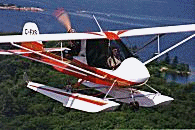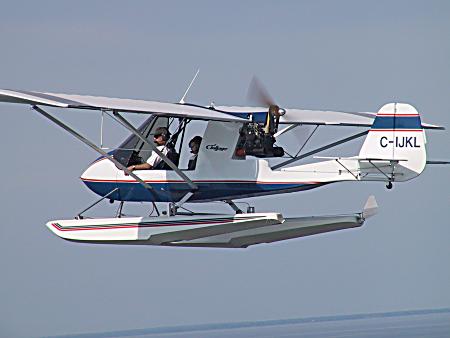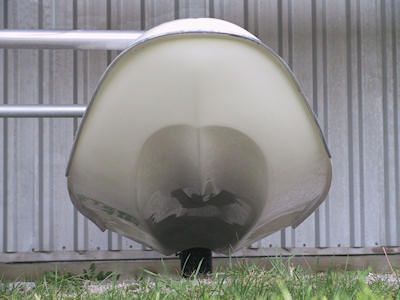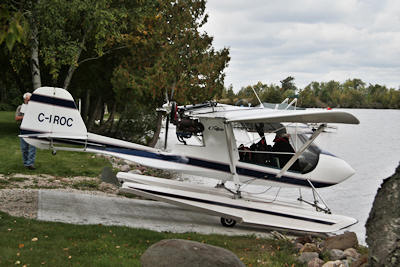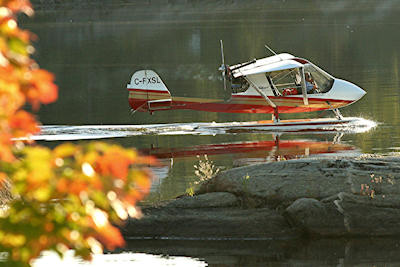|
Home Page | Order Challenger Video | Be Notified Of Web Site Updates | Contact Us Three very different float designs are available for the Challenger: fibreglass, aluminum and inflatable. All three are available in both straight and amphibious configurations. For over 20 years the vast majority of Challenger owners have chosen fibreglass amphibious floats made by Puddlejumper Floats of Canada. Compared to the alternatives, Puddlejumpers are lighter (so you can carry more payload), more hydrodynamic (so you can lift the payload out of the water sooner), and more aerodynamic (so you can carry the payload faster). The numbers speak for themselves - Puddlejumper amphibs only add 105 lbs to your empty weight and they only subtract 10 mph from your cruise speed! Unlike all other floats on all other planes the Puddlejumper amphibious versions have negligible cost, weight and performance penalties compared to straight floats. The flexibility and convenience of choosing freely between water and land operations makes the Puddlejumpers irresistible. The 14 foot Puddlejumpers have 1000 lbs of displacement per float which provides excellent buoyancy for the entire Challenger line of aircraft. Using the conservative requirements for certified seaplanes this allows for gross weights of up to 1111 lbs while still providing 80% reserve buoyancy. This is more than sufficient even for the new Challenger Light Sport XL-65 with its gross weight of 1060 lbs, the highest gross of all the Challenger models. The distribution of the buoyancy favours the front of the floats so they ride well in rough water without burying the bows in the waves. Even taxiing in high winds on turns from downwind to upwind the bows tend not to submerge. Puddlejumper floats utilize a unique tunnel hull design rather than the v-shaped hulls of aluminum floats or the flat-bottoms of inflatables. Patterned after high speed racing boats the tunnel makes a concave channel in the centre of the float which traps air thereby creating lift. The lift together with a minimum amount of hull surface in contact with the water enables much more rapid acceleration to liftoff speed and much easier breaking free from the water. The tunnel hulls break up the surface tension of glassy water - the "suction" effect which makes it hard for floats to get out of the water and airborne in very smooth conditions without ripples or waves. This allows the Challenger with its large wing and high power-to-weight ratio to take off from glassy water in a fraction of the distance of other aircraft/float combinations. The hulls of the Puddlejumper floats are constructed of fibreglass and each pontoon has three watertight compartments separated by bulkheads. Everything you need to attach the floats to your Challenger is provided. Rigging hardware is aircraft aluminum and stainless steel to prevent corrosion. An optional Salt Water Operations package of special bearings, bushings, axles and other parts can be installed if desired. Puddlejumpers have an elegantly simple gear retraction/extension mechanism. Cables and gravity are used to avoid electric, air or hydraulic screw ups. The main wheels retract into wells in the pontoons while the nosewheel goes up and down like an upside-down periscope. The steerable nosewheel gives easy maneuvering on land and permits operation in 20 mph crosswinds. The new third generation landing gear is extremely rugged - it is designed for aircraft up to 1232 lbs, well in excess of even the highest grossing Challenger, the Light Sport XL-65 with its max takeoff weight of 1060 lbs. Challengers on amphibious Puddlejumpers operate routinely from grass and dirt venues, not just the smooth pavement required for many amphibs. The third generation amphibs have reinforced hulls, 70% stronger nose gear, larger nose wheels and larger main wheel wells with 6" forks for larger wheels. Hydraulic disc brakes have replaced the drum brakes used in the past. There have been many other less obvious improvements including, for example, a stainless steel wear plate in the nose gear down lock. Options: water rudder, hydraulic disc brakes, coloured gel coat, kevlar hulls. To top all this off, Puddlejumpers cost less too. See why owners prefer them? Seaplane pilots say that float flying is the hard drugs of aviation - instantly addictive! To see why click here, here, here, here, here, here, here and here!!!
To learn and see more order our comprehensive information package and video! |
